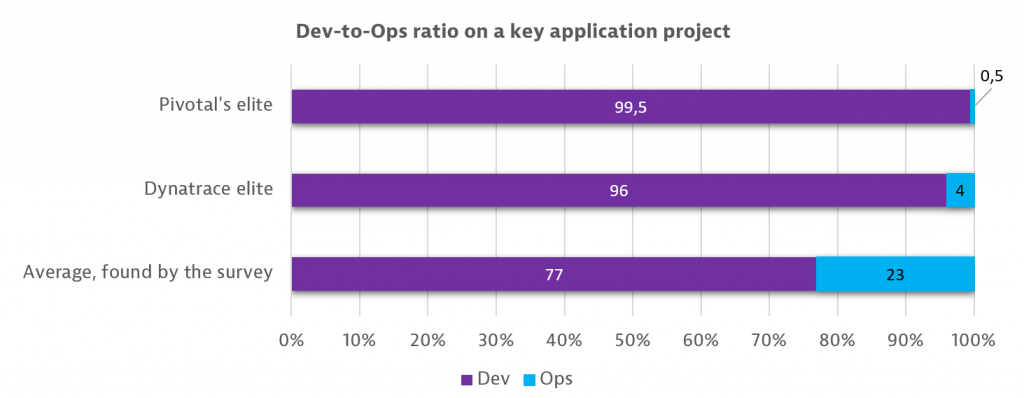Over the last year we’ve seen more and more Dynatrace customers move from DevOps to NoOps. These organizations have
built automation into their DevOps environments to a degree that there is no longer a need for a traditional Ops team to
manage software in-house. This move toward massive automation has resulted in better products, improved quality, and
better culture. Dynatrace customers are now seeing faster feedback loops, increased productivity, and lower MTTR.
Developers feel more responsibility for Ops success, too.
While we’re always eager to hear the stories of pioneering Dynatrace customers, for this study we really wanted to
better understand the reasons why other organizations aren’t taking this same approach to NoOps.
Welcome to the Dynatrace ACM Survey
Earlier this year, we provided the Dynatrace Autonomous Cloud Survey to over
100 organizations so that we could better understand what is holding companies back from taking the next steps in their
cloud automation journey. The survey had eight questions related to current team effectiveness and system stability.
These assessments helped us understand the need and effectiveness of automation in cloud pipelines. It also gave
participants a baseline result on where their organizations stand, and where they can improve.
In this blog series we’ll share what we’ve learned so far. Read on to discover where you’re ahead of your peers, where
you’re falling short, and what you can do today to become a high performer.
Question #1: What is your Dev-to-Ops ratio on your most critical application project?
- Learning #1: To a large extent, development teams still rely heavily on
Operations engineers.
Development and Operations team sizes depend heavily on the type and scale of the applications they work on. The ratio
of the two shows to what extent Operations activities–for example problem remediation–have been automated.
According to our survey, on average, four developers have one Operations engineer to support them. By looking at the
survey’s results, we found that teams fall into one of four categories:
- Teams still struggling with manual operations
- Dev-to-Ops ratio between 1:1 and 3:1
- About 40% of respondents
- Teams having at least partly automated operations
- Dev-to-Ops ratio between 4:1 to 7:1
- About 36% of respondents
- Teams running highly automated operations
- Dev-to-Ops ratio of 8:1 or higher
- About 19% of respondents
- The elite category: Teams who have embraced massive automation
- Dev-to-Ops ratio of 15:1 or higher
- About 5% of respondents
As an industry best practice, we like to refer to Pivotal, the developers of Cloud Foundry. According to Pivotal, “Cloud
Foundry adopters running at scale may enjoy a 200:1 developer to operator ratio”. Here’s a quick graphical comparison
of the Pivotal Dev-to-Ops ratio, that of the Dynatrace elite category, and the average ratio identified by the survey.

Where do you want to spend your time and money?
The size and complexity of today’s cloud environments will continue to expand with the speed and innovation required to
remain competitive. Human operators aren’t equipped to adequately manage these dynamic environments. Organizations must
ask themselves: where do we want to spend our time and money? Labor costs and cycle times slowed down by manual process
errors is the wrong answer.
The speed of the digital economy requires a seamless delivery pipeline and automatic remediation actions in case of
failures. Not only does automation produce deterministic and consistent outcomes in large environments, it can also
increase staff productivity, make processes more efficient, and save you a lot of time.
Give your developers more operational responsibility and build processes based on collaboration.
The good news is: there are plenty of different cloud services, PaaS platforms, and other powerful tools on the market
that support almost every aspect of build, release, and operations activities. Just to name a few, with no claim to
completeness:
- OpenShift, Cloud Foundry, or Kubernetes for developing, deploying, and running containerized applications
conveniently and at scale - Jenkins, Concourse, or Atlassian Bamboo for continuous delivery
- GitHub, Bitbucket, or AWS CodeCommit for version control
- Neotys, JMeter, or LoadRunner for load testing
- Red Hat Ansible, Chef, or Puppet for deployment automation
- Ansible Tower or Rundeck for runbook automation
- xMatters, PagerDuty, or VictorOps for incident management
- Slack, JIRA, or Confluence for team collaboration
- ServiceNow or Jira ServiceDesk for ITSM
- …and keptn, the enterprise-grade control plane
for cloud-native delivery and automated operations.
With such a wide range of software development tools, services, and knowledge available today, organizations can now
massively automate their IT operations, up to 100%.
How to get started
How many developers and Operations engineers work on your most critical application project? Do your developers have
operational responsibilities, too? And how about your processes? Are they built on collaboration? Answering these
questions and thinking about a better solution might be your first step in bringing structured automation into your
DevOps processes.
If you’ve found this blog interesting or useful, you so need to read the next part. Part 2 is looking at organizational
silos and how production
monitoring data helps to break them down.
Also, consider taking the Dynatrace Autonomous Cloud Survey yourself to see
how well your organization stacks up against the competition.





Looking for answers?
Start a new discussion or ask for help in our Q&A forum.
Go to forum